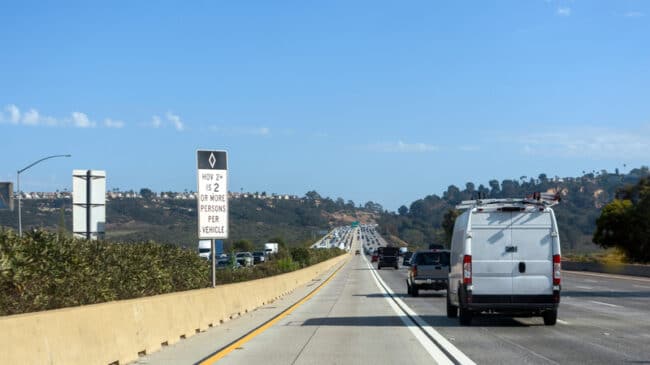High-occupancy vehicle lanes are failing to mitigate highway congestion, due in party to a decline in carpooling. The number of people carpooling has been dropping for 40 years and is now below the level needed to keep high-occupancy vehicle (HOV) lanes viable. One promising solution is to convert carpool lanes into high-occupancy toll (HOT) lanes.
Introduced during the 1970s oil crisis to reduce highway congestion and fuel consumption, HOV lanes are limited to vehicles with two or more people. The purpose of HOV lanes is to offer a less-congested travel alternative to the general-purpose highway lanes by encouraging drivers to carpool. HOV lanes in the United States have various occupancy requirements, including two people (HOV-2) or three people (HOV-3). Vanpools (shared vehicles carrying five to 15 passengers) and transit buses can also use HOV lanes.
During the oil crisis, carpool lanes were successful in managing traffic flow and promoting carpooling. However, once oil prices dropped, many commuters ditched carpooling. While 20.4% of Americans commuted together in the 1970s, by 2008, the percentage of carpoolers had declined to less than 10%. This decline in carpooling has led to empty HOV lanes in many areas.
Three other factors also distort carpool lane usage: the “Goldilocks phenomenon,” fampools, and solo vehicles.
The “Goldilocks phenomenon” draws from the well-known children’s story: It refers to HOV lanes that are too “hot” (overused) or too “cold” (underused). In cities with too-hot HOV lanes, an excess number of drivers use the carpool lanes, causing traffic flow to slow and leading vanpools and buses to encounter the same congestion as the other lanes. This reduces the number of people per hour that the lane can carry. It also dissuades commuters from using bus services and reduces vanpool formation because those modes must deal with significant traffic congestion.
In contrast, too-cold carpool lanes are underused while general-purpose lanes are full. These carpool lanes can tarnish public opinion of HOV lanes because drivers stuck in traffic perceive them as wasteful. In many drivers’ minds, empty carpool lanes should be converted to general purpose lanes open to all drivers.
Additionally, many vehicles in HOV lanes are not the types of carpools—workers commuting together—that planners envisioned. Many in carpool lanes are fampools, vehicles with passengers from the same household traveling to the same area. Today, fampools make up around 41% of carpool vehicles. Because these fampoolers would travel together regardless of whether there was a carpool lane, they aren’t reducing the number of vehicles on the road.
Since enforcing occupancy requirements in carpool lanes is challenging, many solo drivers use the lanes without penalty. While police can and do ticket solo drivers for entering HOV lanes, they have other priorities, and the volume of solo drivers willing to try to use them, limited technological capabilities, and lack of a proper observation area mean law enforcement is somewhat limited in enforcing carpool lane occupancy rules.
The Federal Highway Administration (FHWA) does have a stick for poorly performing HOV lanes: the maintenance of minimum average speeds. When average travel speeds drop below 45 miles per hour, it can require states to either increase occupancy requirements, convert the HOV lane to an HOT lane (which may include increasing occupancy requirements), or pay back the federal funding used to build the HOV lane (usually 90% of the overall cost).
States should start converting their HOV lanes to HOT lanes. With high-occupancy toll lanes, solo drivers pay to use the lanes, but carpools, vanpools, and buses do not. Given the large number of two-person fampools and limited capacity in HOT lanes, many transportation agencies will convert a 2+ HOV lane (two or more people traveling together can use the carpool lane) to a 3+ HOT lane (three or more people traveling together can use the toll lane for free).
It is easier to enforce carpooling with a 3+ person per vehicle requirement. In addition, HOT lane operators often use electronic (occupancy detection) enforcement.
Unlike some toll roads, which use a flat rate per mile, most of today’s high-occupancy toll lanes use dynamic pricing. The level of traffic and demand for the HOT lane dictates the price of the tolls, which rise during heavy travel periods like rush hour. The tolls are priced to ensure the HOT lanes remain free-flowing even during peak hours.
High-occupancy toll lanes are a better option than carpool lanes for most urban areas today. Minimizing traffic congestion in HOT lanes keeps those lanes an attractive option for drivers who need quicker trips, which can also help reduce congestion in adjacent general purpose lanes. HOT lanes also help address the HOV lane enforcement problem. And the toll revenue from solo drivers paying to use the HOT lanes can be reinvested into other highway projects in the corridor, such as highway maintenance, public transit improvements using the lanes, electronic tolling collection and enforcement, or recouping the costs of the HOV-to-HOT lane conversion.
Today’s transportation agencies should not accept the subpar conditions and results being achieved by HOV lanes. Drivers, transit users, and states would benefit from converting failing carpool lanes into high-occupancy toll lanes.

